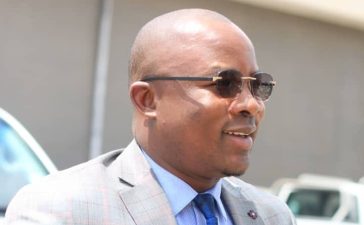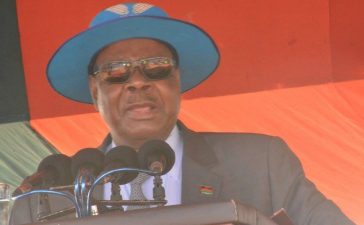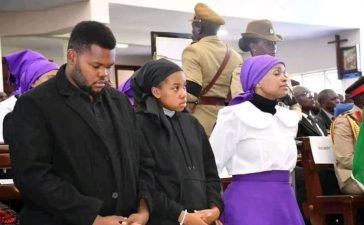BY JACK MACBRAMS
There’s something deceptively serene about the gated compound on the corner of Glyn Jones Road and Mtunthama Drive in Lilongwe’s Area 3 suburb. The plush foliage that conceals the semi-hoary residences might as well hold a sacred truth. This is where the story begins.
23-year-old Area 11 resident Kottana Chidyaonga was effortlessly beautiful; and with an easy smile, an engaging and outgoing personality, she was a well-known socialite. Close friends describe her as outgoing and easy to get along with.
“She had a vibe. She was the life of the party,” one of her friends, Ekaree Daniela Chaweza, describes her.
“We were very close friends, although we had known each other for only four months. But from our first interaction, we spent every weekend together. She was bubbly, she was sweet, and she had infectious laugh. When she laughed, you would know that Kottana was laughing. Thinking about it now, she was full of life,” Chaweza told us in an interview.
The Fateful Night
Around midnight on January 3, 2020, accompanied by her friend Diana Bhagwanji, Kottana arrived at the Area 3 compound to meet up with her boyfriend, Timothy ‘Timmy’ Ntilosanje, then aged 28. Timmy was in the company of close friend Gilbert Kamaliza, 30, and his girlfriend Ekaree Daniela Chaweza, 23.
According to court dockets, about 30 minutes later, Kottana and Diana bade farewell to the trio but, as Timmy walked Kottana and Diana to their car, Kottana stepped on and was bitten by a snake.
“We were in the house when it happened. They had just stepped out when Timmy ran back to tell us that Kottana had been bitten by a snake,” Chaweza told us.
A decision was made to take Kottana to a medical facility, but not before the guard, Elasimu Lusiyo, was asked to find the snake. He found the snake in the garage and hacked it with a machete, completely cutting off its head.
However, witness depositions show that at the time, Kottana was not under any distress nor was she displaying any signs of pain. A decision was made to head to the closest medical facility, Care Polyclinic, which was within the vicinity of Area 3.
They arrived at the clinic around midnight where Kottana was attended by Dr. Ruth Chimutu who, upon examining her, decided that the right medication would be antivenom, a serum of antibodies that would quickly neutralize the venom in her system.
Care Polyclinic Fatal Gaffes
In the court case that ensued, we learn that Care Polyclinic pharmacist Rafick Mustaphar, who was on duty on that fateful night, was approached to provide antivenom for Kottana.
In court, Mustaphar testified that he checked the fridge where they normally store such drugs but did not find it. When he inquired from a fellow pharmacy technician, only identified in court documents as Hamil, he was directed to the drug vecuronium bromide, which was in the medicine cabinet. Mustaphar went and looked, found the drug, and gave it to the nurse who proceeded to administer the drug.
Mustaphar told the court that he was new on the job and was not competent in drug use and administration.
During cross-examination, he averred that he lacked extensive experience in his field, having been employed for only a few months. He further stated that he did not know about all the drugs, including vecuronium bromide and antivenom, as his diploma curriculum did not cover extensive material.
Mustaphar also testified that according to the regulations of his profession, he was supposed to work under a supervisor always, but on this night, and on many other nights, he worked unsupervised as the supervisor rarely came to work.
The Lethal that is Vecuronium
Vecuronium bromide has been used as part of a drug cocktail that prisons in the United States use to put a condemned prisoner to death. Vecuronium is used to paralyse the prisoner and stop breathing, in conjunction with a sedative and potassium chloride to stop the prisoner’s heart. Injections of vecuronium bromide without proper sedation allow the person to be fully awake but unable to move in response to pain.
In Kottana’s case, this explains why, after a few drops of vecuronium had been administered via drip, she had a brief episode of convulsions, as per the State’s dockets on the matter.
According to the court documents, at that point, Dr. Chimutu ordered the nurse to stop administering the vecuronium drip.
As Kottana’s situation deteriorated, she was given respiratory support and the doctor began resuscitation to help her regain her heartbeat, which she succeeded in doing.
In a space of 15 minutes, the situation had turned from being normal to being grave.
“We arrived at the clinic around midnight, so we were the only ones there. It was pretty normal, and we were actually joking and laughing when we got there. But in a space of 15 minutes, the waiting area went from being normal to being dead quiet,” Chaweza explained.
With her condition deteriorating, Kottana was rushed to Kamuzu Central Hospital in an ambulance, where respiratory support was continued. 30 minutes later, a little after 1 am, Kottana was pronounced dead.
But the drama was just beginning to unfold.
At the hospital, Kottana’s cousin Thokozani Kaunda arrived soon after she died and engaged both Timmy and Bhagwanji to understand the events leading to his cousin’s death.
He says he noticed some inconsistencies in the stories, prompting him to report the matter to Lingadzi Police Station in Area 18 and demand a post-mortem to be conducted to determine the cause of death.
On Sunday, January 5, 2020, a day after Kottana’s death, her family engaged Malawi’s leading pathologist Dr. Charles Dzamalala to conduct a forensic post-mortem to establish the exact cause and mode of death.
The Autopsy Reports that Triggered Arrests
In his six-page report, Dr. Dzamalala said he found evidence of the toxic substance, temik, in Kottana’s body and concluded that she died of unnatural causes.
“The death…was due to generalised haemolysis following acute poisoning with a pesticide called temik…Based on the circumstances surrounding this death, as per narration above, this incidence of acute poisoning is most probably due to a homicidal act rather than suicidal or accidental,” he wrote in his January 13, 2020, report.
Based solely on Dr. Dzamalala’s medical opinion, on January 15, 2020, 12 days after Kottana’s death, Police arrested Timmy, Bhagwanji as well as Gilbert Kamaliza, and Ekaree Daniela Chaweza for murder. This is premised on the fact that Kottana had been poisoned between 9 pm and 11 pm, during which time she had encountered the four individuals.
“The particulars of the alleged offence are that Timothy Ntilosanje and three others during the night of 3rd January 2020 at Area 3 in the district of Lilongwe, with malice afterthought, caused the death of Kottana Chidyaonga,” reads the State’s submission to the court.
The Arrests that Messed up Lives
Chaweza says her arrest changed her life forever.
“I didn’t know how serious this was, but the moment it clicked was when I was arrested, and the Police were recording my statement. In the Police book where they record particulars of people arrested, next to my name they wrote murder in bold red letters.
“And then after I was done, the Police officer said I could sit down. So, I pulled a chair and sat down, but he shouted at me saying: ‘Who do you think you are, sit down, on the floor!’ That is the moment I understood that whatever privilege I had, was now gone,” she said.
Chaweza, who is a psychologist, lost her job because of the arrest. She is also a fashion designer who owns the House of Daniela brand, and she had been voted the best new designer before her arrest.
“The arrest affected my brand and my life. Because the first thing you see when you google my name is that I was arrested for murder,” she says.
Dzamalala Defends Autopsy Report
In his autopsy report, Dr. Dzamalala further concludes that the snake bite narrative lacks scientific evidence and is, therefore, best ignored.
“A typical snakebite wound is visibly fresh, leads to swelling from about quarter of an hour after the bite, and takes specific shapes (arc for non-venomous bites and linear or otherwise for venomous bites). The alleged snake bite wound on the body of late Kottana Maria Chidyaonga lacked all these classical supporting features on the skin surface, both grossly and microscopically,” he infers.
Having concluded that Kottana had died because of acute temik poisoning based on toxicology tests carried out at the Toxicology Unit in Lilongwe, Dr. Dzamalala told the court that he abandoned further tests, including snake venom and drugs.
Under cross-examination, Dr. Dzamalala acknowledged the existence of vecuronium bromide, which was wrongly administered to the patient, he argued that it was not fatal.
When confronted further, he became defensive and challenged that he was prepared to defend his position and findings at all costs.
Dr. Dzamalala told the court that he had been paid by Kottana’s family to conduct the autopsy, at which point the defence lawyer asked him the number of times that he had been paid to do an autopsy and the results have come out against the suspicions of those who paid for it.
The court has it on record that he refused to answer this question.
In an interview, Dr. Dzamalala explained the process that led him to conclude that Kottana was poisoned.
He explained that when he commenced the autopsy, he noticed that there were tell-tale signs of poisoning such as a bulge in the stomach bowel.
The pathologist noted that the toxicology results conducted at the Central Veterinary Laboratory in Lilongwe confirmed his fears when the specimen tested positive for temik.
“There are three results that can emanate from the toxicology tests. The first is that there will be no traces of poison in the samples. The second is that they could find traces of poison that matches the poisons that the lab has in their inventory. And the third is that the test could find poison that does not match what they have in their poison inventory,” he said.
He explained that after the samples returned positive for temik poison, he abandoned further investigations.
“Because if there were indeed other elements in the specimen, such as vecuronium bromide or snake venom, they should have been detected by the toxicology tests as a third option, one which was not in the inventory and we could have sent the samples outside for further tests to determine the poison,” he said.
In drawing the conclusion that Kottana’s case was homicide and not suicide, Dr. Dzamalala said he based this on the fact that suicide is prompt while homicide is meticulous.
“When someone has decided to kill themselves with temik, they do it promptly without too much thought while when you want to kill yourself, you take your time to plan.
“Medically, what this means is that, in suicide cases, the victim ingests the poison quickly, and as such, you will find granules in the stomach as the first diluted granules of temik will kill you instantly, but some remnants will be seen in the stomach. While in homicide cases, you know that if you put temik in the drink or food, the person will notice it, so you dilute it first before mixing it with the drink. In Kottana’s case, there were absolutely no granules of temik,” he said.
Experts Differ with Dzamalala
However, in a twist of events, several medical experts have discredited Dr. Dzamalala’s autopsy.
A January 28, 2020, report from the Ministry of Health to the Director of Criminal Investigations at Area 30 clearly states that Chidyaonga died because Care Polyclinic administered a wrong drug—a clear case of medical negligence.
A damning five-page report, authored by top government medical experts Dr. Samson Mndolo and Dr. Frank Sinyiza, notes that when she arrived at the clinic, Chidyaonga was not given anti-venom as should have been the case for someone who had been bitten by a snake. Dr. Mndolo is hospital director at Queen Elizabeth Central Hospital, while Dr. Sinyiza is hospital director at Mzuzu Central Hospital.
Care Polyclinic tried to cover up their mistake by claiming that they had administered antivenom. But the two government doctors clearly point this out as a lie.
“Antivenom is nowhere on the list of items used, despite the patient’s notes showing it was given as an infusion…Why didn’t the hospital bill the antivenom if it was one of the drugs used?” Mndolo and Sinyiza wonder in their report.
The two doctors note in the report, instead of antivenom, the clinician administered a drug called vecuronium.
“When one compares the doctor’s notes with the billing list of items, it becomes confusing. The notes state that antivenom was given, but the list of medicines on the billing sheet does not have it. Instead, [the billing list] has vecuronium which is never mentioned in the doctor’s notes,” adds the report.
The doctors, thus, conclude that the muscle relaxant vecuronium may have been mistaken for antivenom and was given straight to the bloodstream as treatment for the snake bite.
According to the Mndolo/Sinyiza report, almost all patients stop breathing after getting a dose of muscle relaxants such as vecuronium.
“If breathing is not assisted on time, the heart can stop as a result of oxygen deprivation, a state called cardiac arrest,” the report reads.
According to the doctors, when vecuronium is administered to a patient with respiratory support, as the respiratory muscles slowly weaken, the amount of oxygen one is breathing in falls significantly (respiratory failure).
“The brain is starved of oxygen, and convulsions and loss of consciousness may follow (hypoxic brain damage). Finally, spontaneous breathing completely stops. After which the heart is starved of oxygen and stops (a state of cardiac arrest). If cardiopulmonary resuscitation of oxygen does not commence at this point, death is likely to occur,” the Mndolo/Sinyiza report explains.
The two doctors then conclude that based on the facts, Kottana Chidyaonga may have received an accidental dose of muscle relaxant vecuronium which was mistaken for an antivenom.
“This led to respiratory muscle paralysis followed by a hypoxic cardiac arrest,” they conclude.
Another Doctor Faults Dzamalala
Another autopsy by pathologist Associate Professor Dr. Steve Kamiza of Kamiza Pathology Lab in Blantyre further questions Dr. Dzamalala’s autopsy results.
Dr. Kamiza notes that none of the symptoms known for temik were observed by the attending clinician at the clinic.
“This was 30 minutes after the snake bite, and the snake bite happened several minutes after the ‘poisoned’ food was ingested. If this was a high enough dose to kill the patient, symptoms would have certainly occurred by this time, as absorption is known to occur as rapidly as 5 minutes after ingestion. So one would conclude that either there was no temik ingested, or the ingested dose was so tiny that it could not produce symptoms, i.e., clinically insignificant dose; therefore, Kottana Chidyaonga did not die of temik poisoning,” Dr. Kamiza’s report reads.
Unlike Dr. Dzamalala, Dr. Kamiza also agrees with the two government doctors, in concluding that the cause of death was the mistaken administration of the drug vecuronium.
“The medical record shows that the clinical condition of Kottana changed abruptly from perfect to poor following the course of administration of the snake antivenom drip. The clinician reacted by stopping the drip which meant she sensed that in the drip, was the source of the sudden deterioration of the patient,” Kamiza’s report states.
Dr. Kamiza also wonders why the vecuronium and not antivenom was on the clinic’s billing record.
“Finding of vecuronium drug on the billing record and the absence of the snake antivenom on the same makes one suspect that the drug vecuronium might have been mistaken for snake antivenom and had wrongly been administered in the drip. And knowing the properties of vecuronium as a muscle paralytic agent, it could account for the sudden acute respiratory muscle paralysis with respiratory arrest, and cardiac arrest as described by the records,” he explains.
Dr. Kamiza also contends that Dr. Dzamalala missed the snake bite during the autopsy as he looked at the wrong place.
“There was a snake bite wound on the lateral side of the foot, only that the primary pathologist [Dr. Dzamalala] missed it by looking at the sore on the medial side of the foot. And the snake was unlikely to have been poisonous judging from the lack of presenting symptoms and signs at the clinic, and lack of tissue reaction on the pinhole-sized wound bite,” he said before concluding that the cause of Kottana’s death was acute respiratory failure secondary to administration of a muscle paralysing drug vecuronium instead of snake antivenom.
But during cross-examination by defence lawyers in court, Dr. Dzamalala dismissed his critics, stating that he was the primary expert and authority; hence he ought to be believed over everyone else.
“When asked if he had the opportunity to read reports by Dr. Sinyiza and Dr. Mndolo, he [Dr. Dzamalala] stated that the two doctors were not experts in the field of forensic pathology and could therefore not counter his report. He further emphasised that he disagreed with all the doctors who had testified to the fact that there was a possibility that death was caused by either the snake bite or the wrongly administered drug. He stated that he should be the one to be believed over the rest as he is the expert in the field,” reads the State’s submission of August 12, 2020, to the High Court of a case to answer against the four accused individuals.
And in an interview, Dr. Dzamalala dismissed Dr. Kamiza’s report.
“He [Dr. Kamiza] was hired to do something that was obvious; to dispute my report. But he did not do an autopsy, he never saw the body and he never saw the specimen. He is not even a forensic pathologist. I am the only forensic pathologist in the country,” he said.
State Says the Four Tried to Conceal illegal Act
In their submissions to the court, the then Chief State Advocate Dr. Steve Kayuni and Senior State Advocate Rose Nayeja, contend that the defendants were most likely trying to conceal an illegal act that the deceased either witnessed or was part of.
There is no evidence in the State’s 21-page depositions to support this claim.
On August 19, 2020, High Court Judge Thom Ligowe found the four defendants not guilty of murdering Kottana Maria Chidyaonga.
“It is clear so far that the charge of murder, in this case, is neither based on the snake bite nor administration of the wrong drug, but the presence of temik in the blood and body tissue samples of the deceased. Admittedly, however, what is lacking is evidence of who might have given the temik to the deceased,” Judge Ligowe noted.
Timmy refused to be interviewed for this story and referred us to his lawyer, Khwima Mchizi who did not pick up his phone on several attempts.
‘Autopsy Reports for Sale’
But we have it on record that Timmy lodged complaints with the Office of the Ombudsman as well as the Medical Council of Malawi against Dr. Dzamalala’s conduct. In the January 4, 2021, letter which was also copied to the Malawi Human Rights Defenders Coalition (HRDC) and the Ministry of Health, Timmy accuses Dr. Dzamalala’s of having drawn a preconceived conclusion before he even began the autopsy.
“He has a suspected cause of death on the mortuary card. The issue is why did he think to conduct a test for temik first before the suspected cause of death? One would ‘assume/suspect’ that the temik is what he wanted to find by specifically conducting that test, and not what the facts on the table were.
“And…he ignored to conduct the said tests as he had already settled his report on the pesticides suspicion, ignoring facts surrounding her sudden passing,” Timmy writes in the complaint.
He further accuses Dr. Dzamalala of tampering with the specimen as the Police did not escort him from the mortuary to the laboratory as per law, which demands that the Police should supervise the process so that it is not affected by any fraud or specimen tampering with samples.
“To this regard, there is a high ‘probability’ that these samples/specimens were tampered with or spiked in-transit in the process of taking them to the lab, which he did alone and unsupervised. His report, therefore, lacks credibility,” Timmy says in his letter.
Therefore, Timmy contends in his letter, Dr. Dzamalala might not have done the actual test, or he deliberately ignored some things.
Among other things, Timmy says Dr. Dzamalala drew his conclusion based on “a strong index of suspicion” and not scientific proof. “When the science had to come first since that is what he is qualified for and not probability which is based on assumptions.”
In the letter, Timmy appeals to the Medical Council of Malawi to carefully look into Dr. Dzamalala’s conduct to ensure liability, accountability, and instill trust in the Malawi medical system without looking at rank, qualification, or influence.
“With the issues raised above, I am tempted to conclude that this is how he conducts his autopsies as such, many innocent people could be languishing in jail because of him. And, for the integrity of future reports, it is important that you look into his conduct and assure the nation that he acts above board ethically and professionally,” he says.
Timmy also calls for a review and regulation of the autopsy process in the country to ensure neutrality.
“…these are asked for by the deceased’s family directly to the pathologist, already with a hint of suspicion when, in fact, a complaint should perhaps be filed with the Police and for the Police to make a neutral request because if the process is not regulated, these will continue to become ‘autopsy reports for sale.”
But Dr. Dzamalala dismissed fears that he could have tampered with the specimen.
“Let’s say, for argument’s sake, I indeed put temik in the samples but how could I have removed the snake venom and the vecuronium from the specimen? They should have been detected by the toxicology tests,” he said.
Medical Council Awaits Board’s Ratification
The Medical Council of Malawi (MCM) confirmed to have received complaints of medical misconduct against both Polyclinic and Dr. Dzamalala.
Richard Ndovie, the MCM’s Assistant Registrar (Professional Practice), said in an interview the complaints were investigated, but a final decision awaits the MCM Board’s ratification.
“The reports were subjected to the Disciplinary Committee, where both the complainants and the accused practitioners and hospital representatives were afforded an opportunity to explain their side of the story in the interest of fairness and justice. The Committee made determinations to both cases in addition to other cases that were processed at that particular time.
“We will present the Committee determinations to the Medical Council of Malawi Board for ratification. It is at that particular time that the Board decisions are communicated to the complainant and the accused practitioners and hospitals,” he said.
According to Ndovie, the council envisages holding a Board meeting at the end of March.
Care Polyclinic Awaits Council’s Determination
Shiv Kumar, who owned Care Polyclinic at the time of the incident said he is waiting for the Medical Council of Malawi’s determination on the matter.
“I don’t know where you got this report from. Because as far as we are concerned there was an inquiry by the Medical Council of Malawi and we are waiting for the results,” he said.
Kumar, who shut down and sold Care Polyclinic in October 2020, claimed he had not seen any of the medical reports blaming his facility for medical negligence.
“As I said, all our staff appeared before the medical council and we are just here waiting,” he said.
Families Still Traumatised
Having spent 34 days on remand at Maula Prison, it is not clear whether Timmy and his three friends or the Chidyaonga family will pursue legal action against any of the parties involved.
In a brief interview, Kottana’s mother said the family had not discussed the issue.
“It is a very sensitive issue and as a family, we have never discussed this,” she said.
In separate interviews and speaking independently, both Chaweza and Kamaliza, who got engaged last April, said they had not discussed the issue as a group.
Kamaliza told us that the arrest disrupted his life, both emotionally and professionally.
“I lost track of the way things were moving in terms of career and education advancement. I was lucky that I didn’t lose my job because my employers understood my predicament,” he said.
Kamaliza, who works as an accountant for a Lilongwe firm, disclosed that he had enrolled for a Masters of Business Administration degree with the University of Derby at the time of his arrest but lost out on the life-changing opportunity as the priority was to settle his legal bills and he could hardly afford to pay the university fees.
“Also, I have struggled with mental breakdowns, and I have had to undergo counselling for over five months. Jail is not a good place to be. Because even after all these months, the healing process is not done for me,” he said.
He says the group is yet to discuss whether to seek legal redress for wrongful arrest.
“We haven’t discussed that yet. Everyone was going through a lot of things. We just wanted to get back to normal life,” he explained.













